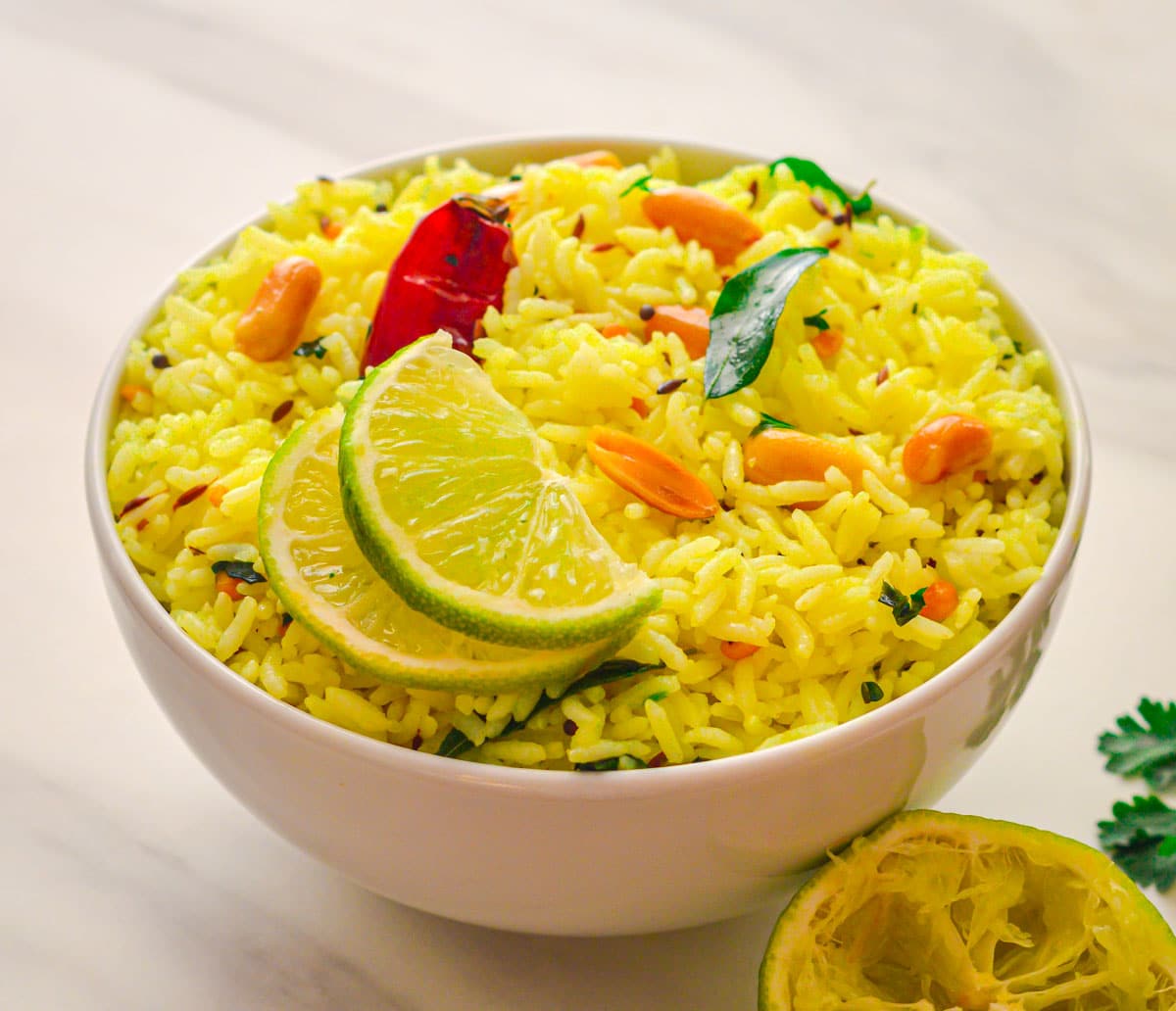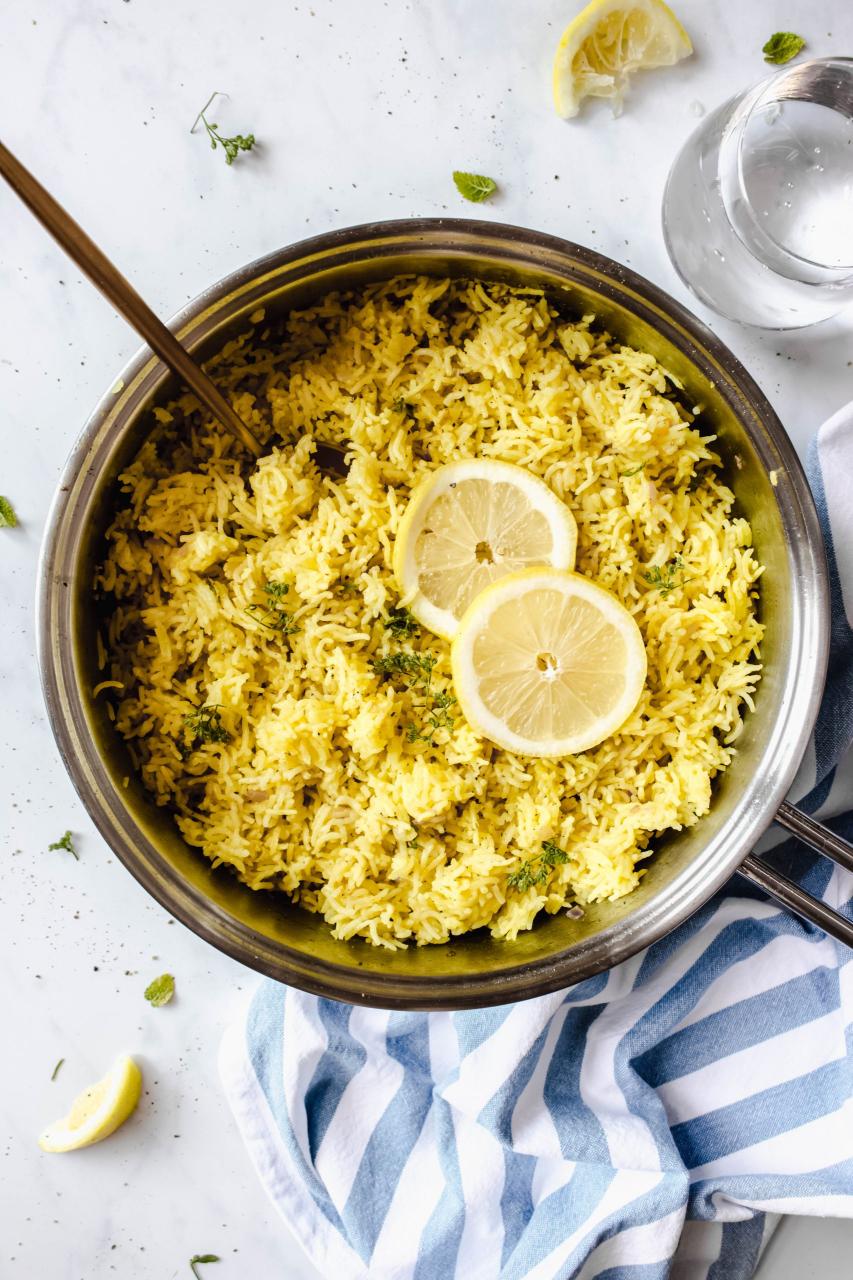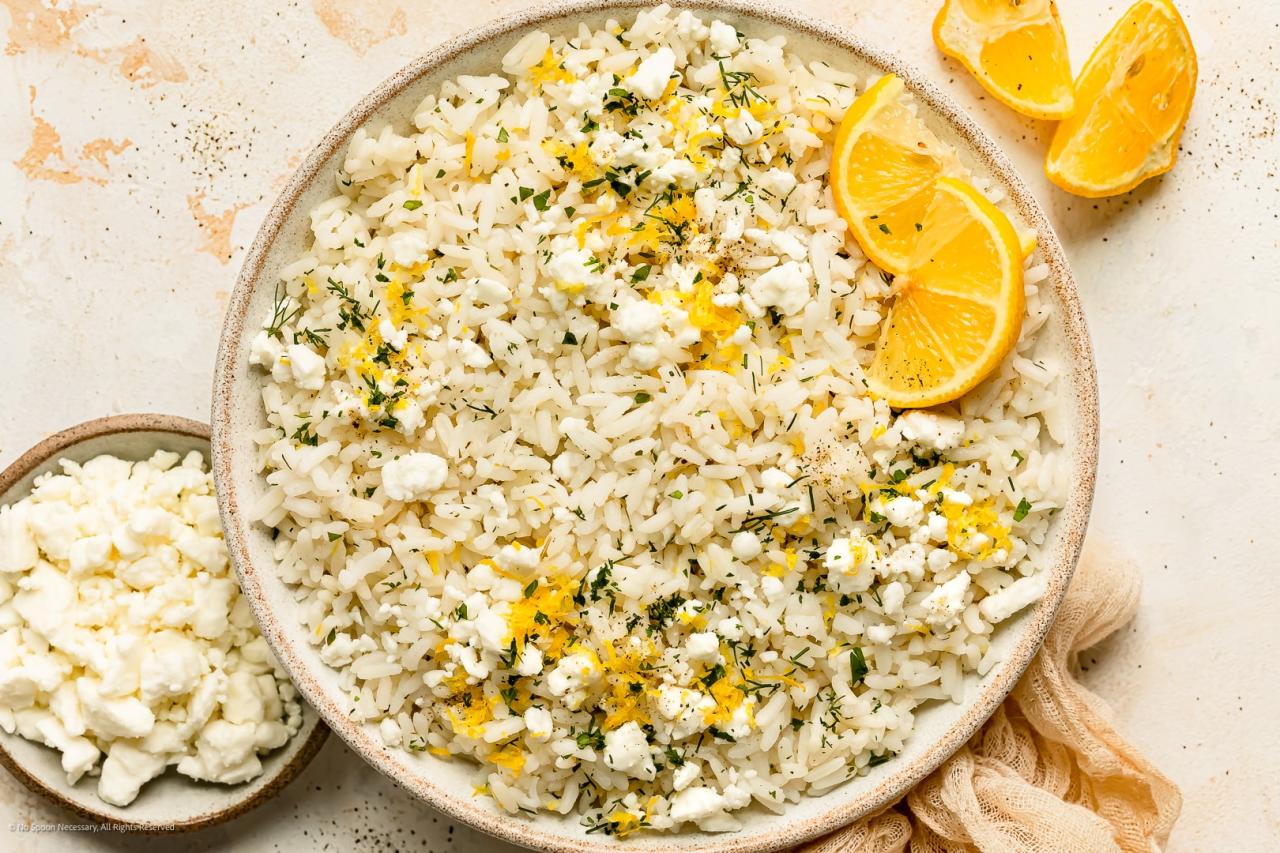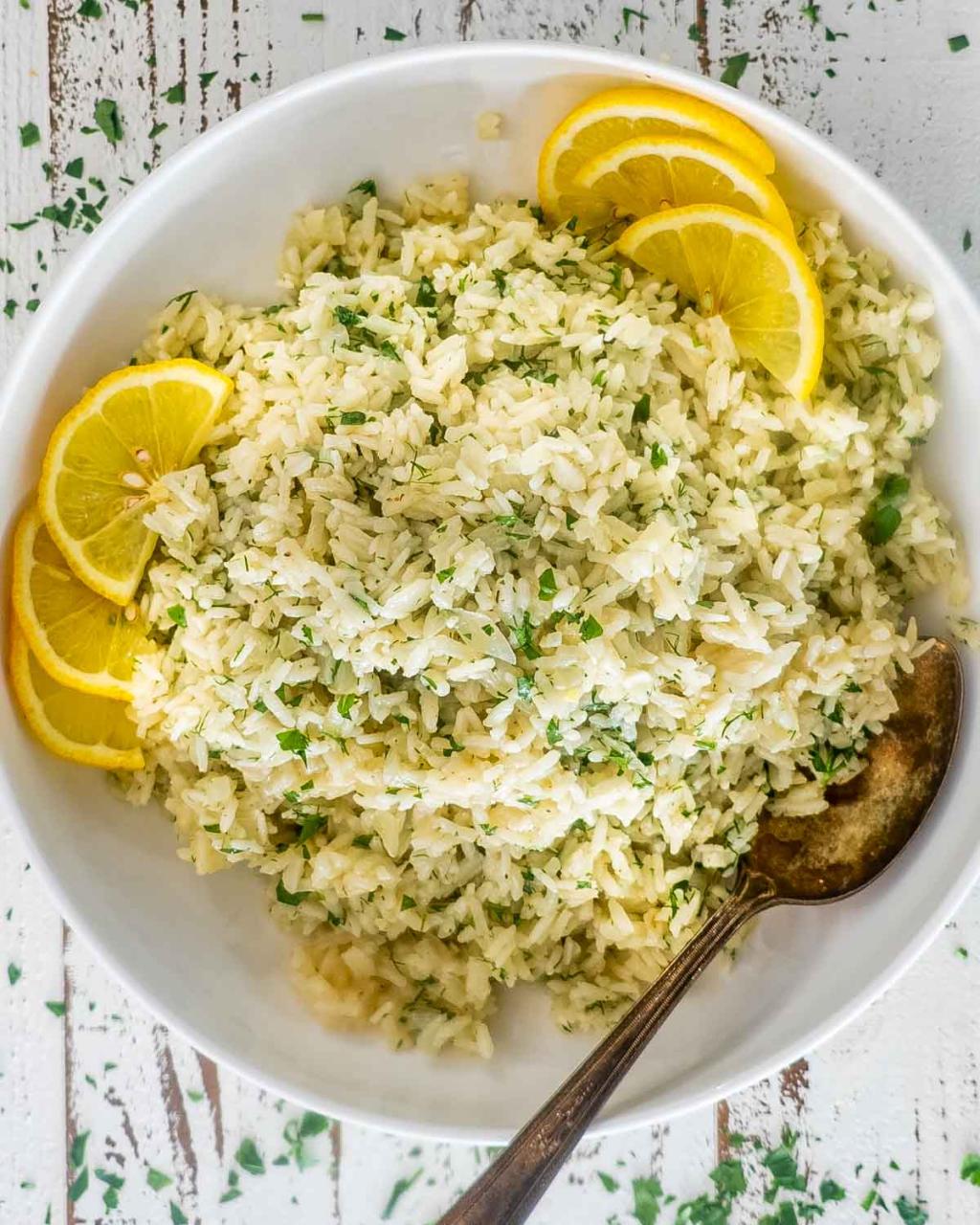Lemon rice is a South Indian dish that is not only popular in the regions of Tamil Nadu, Karnataka, and Andhra Pradesh, but has also gained popularity across India and among Indian cuisine enthusiasts worldwide. This dish is characterized by its vibrant yellow hue, tangy flavor, and aromatic spices that complement the citrus note of lemon.
The preparation of lemon rice typically begins with cooking rice until it is fluffy and non-sticky; leftover rice is often preferred as it gives the best texture to the dish. Once the rice is prepared and cooled, it is then tempered with a variety of ingredients such as mustard seeds, curry leaves, turmeric powder, asafoetida (hing), green chilies, and sometimes nuts like cashews or peanuts for added crunch. The tempering process involves heating these ingredients in oil to release their flavors before mixing into the rice.
Lemon Rice Recipe


Lemon Rice
Equipment
- 1 large skillet
Ingredients
- 1 cup short-grain rice such as sona masoori, rinsed with cool water, drained, and cooked according to the package instructions
- 1 tablespoon coconut oil
- 1 teaspoon mustard seeds
- 1 teaspoon husked whole black lentils
- 1 teaspoon Bengal gram
- 2 green chiles finely chopped
- 1 curry leaf sprig
- 3 tablespoons peanuts
- 1 teaspoon ground turmeric
- 11/2 teaspoons salt
- Juice of 1 medium lemon
- 1/4 cup finely chopped fresh cilantro
Instructions
- Spread the cooked rice on a plate, fluff it with a fork, and set aside.
- In a large skillet over medium heat, heat the coconut oil.
- Add the mustard seeds, black lentils, Bengal gram, green chiles, and curry leaves. Cook until the mustard seeds begin to sputter, about 1 minute.
- Add the peanuts and cook for 1 minute. Turn off the heat and stir in the turmeric.
- Add the mustard seed mixture, salt, and lemon juice to the cooked rice and stir until thoroughly mixed.
- Gently fold in the cilantro.
Notes
Cooking Tips about Lemon Rice

Firstly, selecting the right type of rice is crucial. Traditionally, short-grain rice, like Sona Masuri or Ponni, is preferred due to its ability to absorb flavors well. Before beginning the cooking process, the rice should be rinsed thoroughly to remove excess starch, which prevents the grains from sticking together.
Secondly, the cooking of rice should be such that the grains are fluffy and separate after cooking. It’s essential not to overcook the rice as it may become mushy. Typically, a ratio of 1:2 for rice to water works well, but this may vary depending on the rice variety used. It is also beneficial to let the rice cool down before adding the lemon juice, as adding it to hot rice might make it break and become mushy.
For the lemon flavor, fresh lemon juice is recommended over bottled for its fresh and tangy taste. The quantity of lemon juice can be adjusted based on personal preference, but it’s important to introduce it after the rice is cooked to avoid altering the cooking process of the rice. Lemon zest can also be added for an extra punch of flavor.
The tempering or tadka is a critical step in making lemon rice. It typically includes mustard seeds, dried red chilies, chana dal, urad dal, curry leaves, and asafetida (hing). These ingredients are fried in a bit of oil until the mustard seeds start popping and the dals turn golden brown. This process releases their flavors and fragrances, which enhances the final dish.
Additional ingredients like turmeric are added for color, giving lemon rice its characteristic yellow hue, while peanuts or cashews can be included for added texture and flavor. However, ensure these nuts are roasted or fried to a golden color, being cautious not to burn them as that would lend a bitter taste to the dish.
Lastly, the sequence of mixing is also important. The cooked and cooled rice is typically mixed with the tempering and then the lemon juice. Mixing should be done gently, preferably with a flat spatula to avoid breaking the rice grains. Salt should be adjusted after adding the lemon juice, as the sourness can sometimes give the perception of less salt.
Serving suggestions about Lemon Rice

- Yogurt or Raita: To balance the zestiness of the lemon, a side of plain yogurt or cucumber raita can provide a creamy and cooling effect.
- Papadams: These crisp, thin wafers made of lentil flour are traditionally fried or roasted. Serving papadams alongside lemon rice adds a delightful crunch.
- Coconut Chutney: A side of coconut chutney can complement the citrus notes with its subtle sweetness and creamy texture.
- Pickles: Indian pickles, known for their spicy and bold taste, can be served in small quantities to provide a burst of flavor.
- Grilled or Roasted Vegetables: Grilled vegetables like bell peppers, zucchini, or eggplant can add smokiness and a contrasting texture to the soft rice.
- Protein: Lemon rice can be served as a main dish with a source of protein on the side, such as grilled chicken, fish, or paneer, to transform it into a well-rounded meal.
- Salad: A light salad, with ingredients like tomatoes, onions, and a hint of lemon dressing, can offer a fresh and crunchy side to the meal.
Top 5 FAQs about Lemon Rice

- What is the best type of rice to use for lemon rice? Basmati or long-grain rice is traditionally considered the best choice for lemon rice due to its non-sticky nature and fragrant scent which complements the flavors of the lemon and spices. However, any variety of rice that holds its shape well after cooking can be used, including medium-grain rice or pre-cooked leftover rice, as the dish is quite versatile.
- How do you achieve the perfect balance of lemon flavor in lemon rice? Balancing the lemon flavor in lemon rice involves using the right amount of lemon juice according to the quantity of rice and personal taste preference. Start with the juice of one medium-sized lemon for two cups of cooked rice. The tartness should be palpable without overpowering the rice. For best results, add the lemon juice off the heat to avoid it becoming bitter.
- What spices are typically used in lemon rice, and can they be adjusted? The common spices used in lemon rice include mustard seeds, cumin seeds, turmeric powder, asafoetida (hing), green chilies, and curry leaves. These ingredients provide a depth of flavor and aroma that complements the acidity of the lemon. Adjustments can be made based on availability and dietary preferences, but the typical flavor profile includes a mustard base with a hint of turmeric.
- Can lemon rice be made in advance and stored? Lemon rice can be made in advance and stored in the refrigerator for 1-2 days. In fact, some prefer it after the flavors have had time to meld. When storing, ensure the rice has cooled down and is placed in an airtight container to maintain freshness. Reheat gently, adding a little water if necessary to prevent the rice from drying out.
- Is lemon rice suitable for special diets? Lemon rice is gluten-free and vegan, making it suitable for those on specific dietary regimes. It can also be customized for other diet considerations, such as substituting white rice with brown rice for a whole-grain option, or adjusting the level of oil and types of nuts used for those sensitive to calories or nut allergies.
Lemon rice is a popular South Indian dish that is not only flavorful but also quite versatile and easy to prepare. The primary ingredients typically include cooked rice, lemon juice, turmeric, and mustard seeds, along with various other spices and a garnish of nuts or lentils for added texture. The dish is known for its vibrant yellow color, tangy taste, and the fresh aroma of lemon, often accentuated with the use of curry leaves.

Leave a Reply